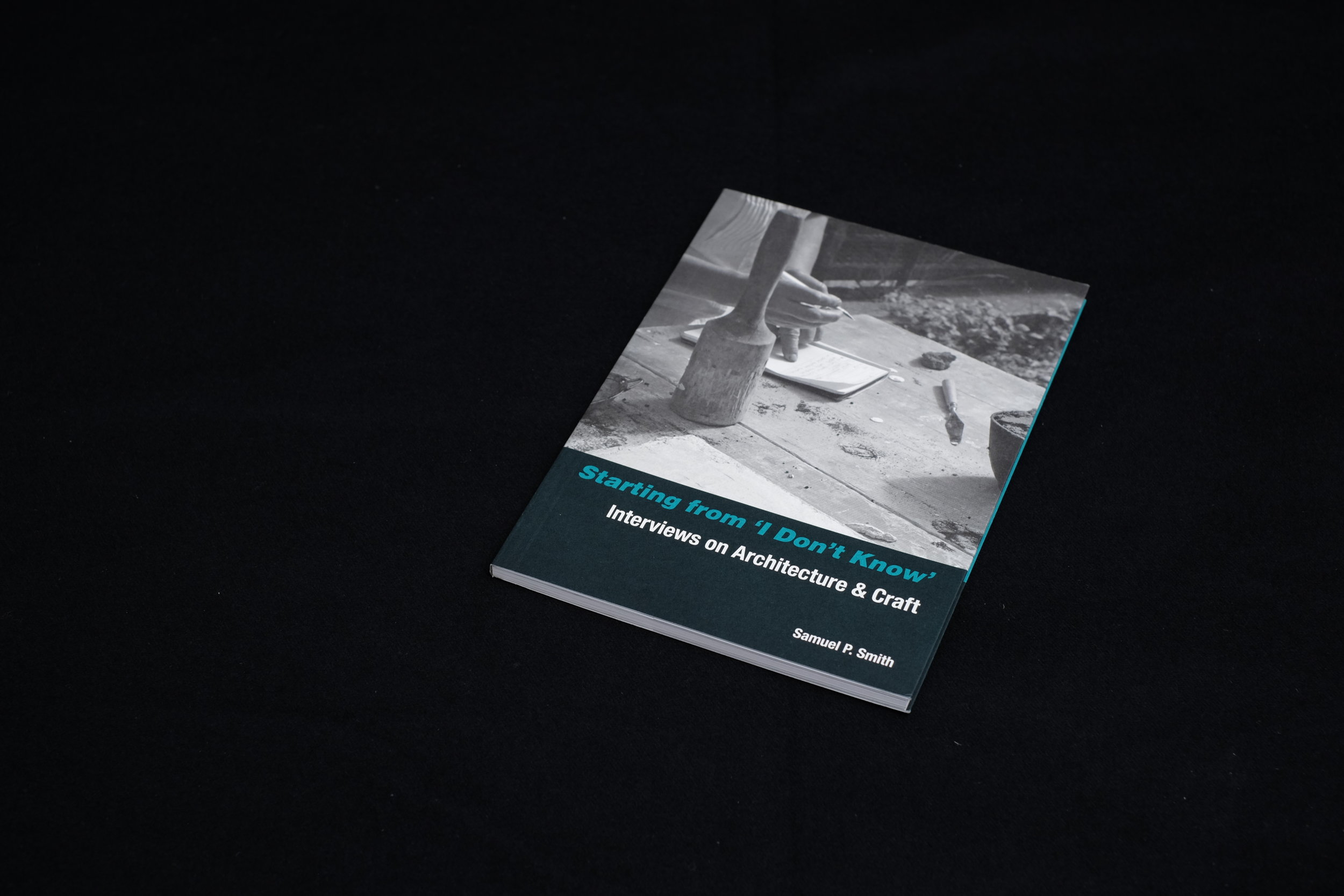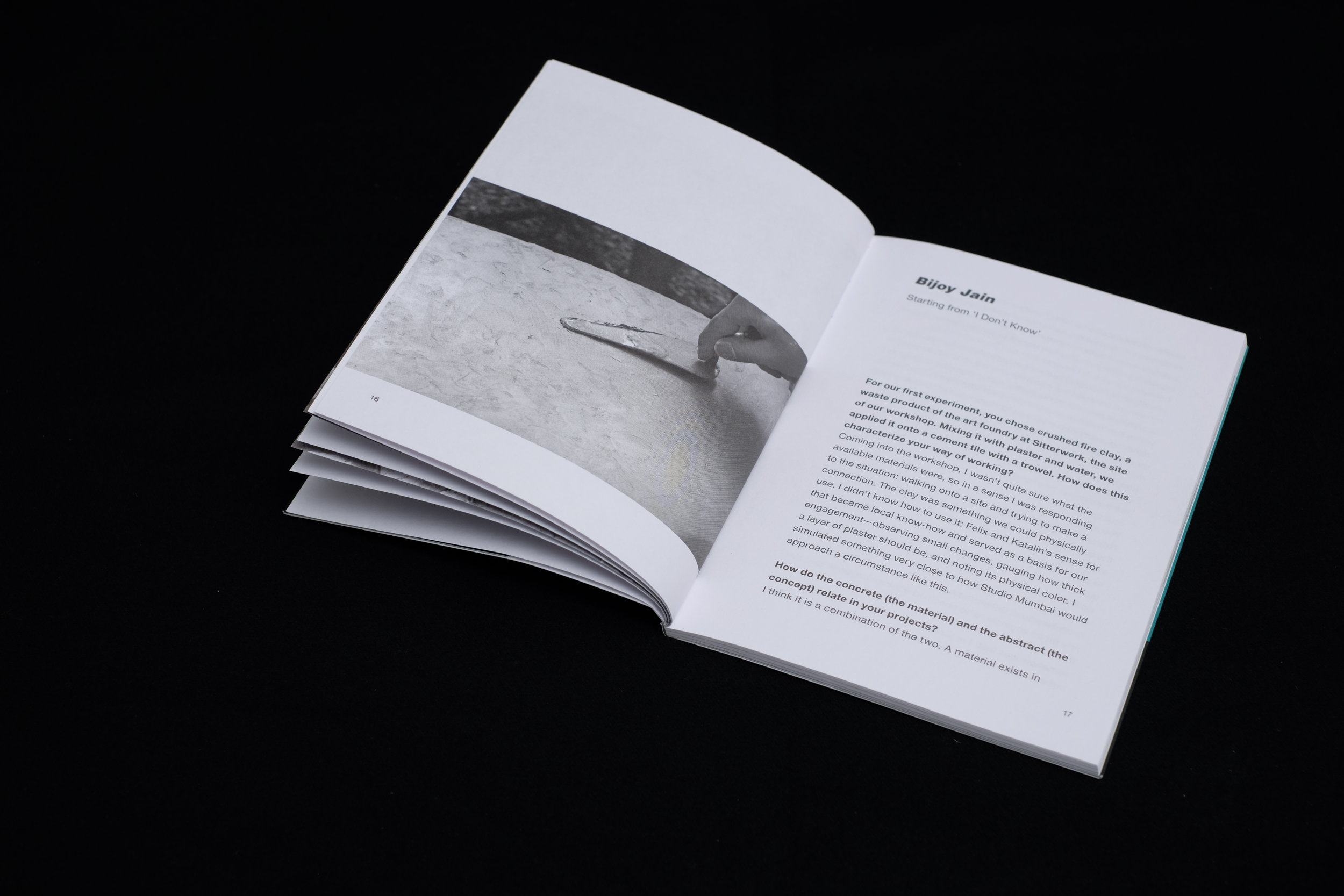Starting from "I Don't Know"
Starting from ‘I Don’t Know’ documents a 2011 week-long workshop at Sitterwerk, St. Gallen, in which Studio Mumbai’s Bijoy Jain joined expert craftspeople from Switzerland to share the knowledge, techniques, and insights from their own practices with students, artists, and architects. The interviews in this book explore the creative potential of hands-on learning, local knowledge, and open experimentation. Celebrating the role of chance and collaboration in the process of making, Starting from ‘I Don’t Know’ makes an argument for bringing together the oft-separated areas of architecture and craft early in the design process.
Published by Soberscove Press in 2015 • 72 pages, with black & white photographs • ISBN 978-1-940190-07-5
Available at Hochparterre Bücher (Zurich) and online.
Excerpt from the Interview with Bijoy Jain
For our first experiment, you chose crushed fire clay, a waste product of the art foundry at Sitterwerk, the site of our workshop. Mixing it with plaster and water, we applied it onto a cement tile with a trowel. How does this characterize your way of working?
Coming into the workshop, I wasn’t quite sure what the available materials were, so in a sense I was responding to the situation: walking onto a site and trying to make a connection. The clay was something we could physically use. I didn’t know how to use it; Felix Lehner and Katalin Deér’s sense for that became local know-how and served as a basis for our engagement — observing small changes, gauging how thick a layer of plaster should be, and noting its physical color. I simulated something very close to how Studio Mumbai would approach a circumstance like this.
How do the concrete (the material) and the abstract (the concept) relate in your projects?
I think it is a combination of the two. A material exists in reality — has a color, a texture. The abstract would be my response to this physical material and what this physical material evokes within me — through memory, experience, my dreams. The combination results in an oscillation between the two. If I reverse that and think abstractly, what is then abstract produces a concrete response. The movement between the concrete and the abstract is a continuous process of discovery, within myself, but also within the material, and both are interdependent. The resulting reality connects you to memory: what is there now, or a future possibility. It can capture different points of view, different times; it goes beyond the physical limitations of just being there. That’s how I understand the concrete and the abstract, just purely through the investigation of the material.
You always begin with the concrete, the material?
Not necessarily, it can even just be a random thought, or the random act of cutting the ground, which then triggers an engagement with the material. Palmyra House, for example, began with the idea of very light, suspended lanterns in the palm grove. At first we designed it with highly polished concrete walls, fifteen centimeters thick, cast in a graphite color so they would reflect the landscape. I didn’t know how to engineer concrete at that point, so I had to rely on an engineer, who specified a thickness close to thirty centimeters, and then the entire idea of the project somehow was lost. I realized that I could not rely on an outside source, but only on the skills of those around me. Through the process of chasing that emotional quality of the idea of illumination, we slowly moved to timber. The project developed, the materials developed, but whatever we did was registered against the abstract idea of these glowing lanterns.
How much do the craftspeople contribute to conceptual discourse?
Let me give you an example. During the monsoon, we were surveying a project where basically the central portion of this particular piece of land fills up with water. You cannot physically occupy the space, even though the water level goes down in the dry season. Six of us were rocking in this little canoe, trying to keep it from tipping over, and Jeevaram, who is my head carpenter, was very specific in how he would take a position in that space and described his idea of the structure. That’s a conceptual discussion, so then it’s my turn to respond.
...
I’m curious about making a sound and getting a response. It may be different from what you expected, and bit-by-bit you adjust. It’s like free jazz: with experience you begin to understand the nuances, a certain communication transpires from playing together.
…
Within the confines of the workshop, the collaborations were brief. Do you depend on long-term collaboration within Studio Mumbai?
It depends; sometimes too familiar is not good, because it doesn’t lead to unpredictability. I like to keep the idea of freshness, so while you gain experience, maintaining naiveté or openness is also important, like when you were a kid, or like a first-year student in architecture school. This freshness has a lifespan, but it can also go on forever, always moving. You expand your knowledge and at the same time you are able to come in with no knowledge. We work toward this spirit in Studio Mumbai, an open creativity that extends much further than the group itself.
...
What resistance did you encounter in the workshop?
Things like, “Oh, in Switzerland we can’t do this, we can’t do that.” I don’t believe that’s true; anything is possible, but you have to engage. Architecture is more complex than just making buildings. Emotions, memories, food, etc. are all possible beginning points for architecture. That’s how I like to produce architecture; it keeps me on different journeys that are unexpected. Being curious is very important, and not worrying about how I am going to do it. Rather: let’s explore, let’s see, let’s find out.


